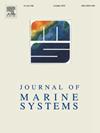Subtidal variability of near-surface salinity in the Cochin estuary, southwest coast of India: Insights from year-long continuous observation
IF 2.5
3区 地球科学
Q2 GEOSCIENCES, MULTIDISCIPLINARY
引用次数: 0
Abstract
A significant knowledge gap exists about the subtidal variations in salinity in Indian monsoonal estuaries due to a lack of continuous data. To address this, we collected high-resolution, long-term near-surface measurements from the Cochin estuary in southwestern India. A wavelet spectral analysis of this data reveals notable subtidal variability in the estuary, with periods ranging from 10 to 90 days. This indicates the presence of intraseasonal oscillations throughout the year, from December 2019 to May 2021. During the wet monsoon season (June–September), subtidal variations in near-surface salinity show amplitudes typically oscillating between 5 and 10 with an average salinity of 6.5, occasionally matching the dominant tidal amplitudes. In the dry season (December to April), the average surface salinity is around 30, and the subtidal oscillation amplitude typically ranges from 3 to 5. We compared the observed subtidal salinity variability with other environmental data, such as rainfall, residual sea-level variability near the estuary's mouth, and water-level variability upstream in the riverine channels. This comparison is used to speculate on the processes controlling the observed subtidal variability. We explored two possible processes that could cause subtidal salinity variability. The first process is the influence of 30–60 day oscillations associated with Monsoon Intraseasonal Oscillations (MISO). MISO involves the northward movement of cloud bands from the equatorial Indian Ocean towards the Himalayan foothills. We present evidence suggesting that coherent oscillations exist in the estuary within the MISO band. The second process relates to the influence of shelf wave propagation along the coast. During the dry season, we observed coherent oscillations in both surface salinity and sea level within a quasi-biweekly (10–20 days) period. The presence of shelf wave propagation along the coast during this season may explain the quasi-biweekly subtidal salinity variations in the estuary. Our findings have broader implications for understanding subtidal estuarine dynamics in monsoonal regimes of the Indian Ocean and other similar regions.
印度西南海岸科钦河口近地表盐度的潮下变化:来自一年连续观测的见解
由于缺乏连续的数据,对印度季风河口的潮下盐度变化存在很大的认识差距。为了解决这个问题,我们从印度西南部的科钦河口收集了高分辨率的长期近地表测量数据。对这些数据的小波谱分析显示,河口的潮下变化显著,周期从10天到90天不等。这表明,从2019年12月到2021年5月,全年都存在季节性波动。在湿季风季节(6 - 9月),近地表盐度的潮下变化幅度通常在5 - 10之间振荡,平均盐度为6.5,偶尔与主导潮汐振幅相匹配。在旱季(12月至4月),平均海面盐度在30左右,潮下振荡幅值一般在3 ~ 5之间。我们将观测到的潮下盐度变化与其他环境数据(如降雨、河口附近的剩余海平面变化以及河道上游的水位变化)进行了比较。这种比较被用来推测控制观测到的潮下变化的过程。我们探索了两种可能导致潮下盐度变化的过程。第一个过程是与季风季内振荡(MISO)相关的30-60天振荡的影响。MISO涉及云带从赤道印度洋向喜马拉雅山麓向北移动。我们提出的证据表明,在MISO波段内,河口存在相干振荡。第二个过程涉及大陆架波沿海岸传播的影响。在旱季,我们观察到地表盐度和海平面在准两周(10-20天)的周期内发生相干振荡。在这个季节,沿海岸的陆架波传播的存在可以解释河口潮下盐度的准两周变化。我们的发现对于理解印度洋和其他类似地区季风状态下的潮下河口动力学具有更广泛的意义。
本文章由计算机程序翻译,如有差异,请以英文原文为准。
求助全文
约1分钟内获得全文
求助全文
来源期刊

Journal of Marine Systems
地学-地球科学综合
CiteScore
6.20
自引率
3.60%
发文量
81
审稿时长
6 months
期刊介绍:
The Journal of Marine Systems provides a medium for interdisciplinary exchange between physical, chemical and biological oceanographers and marine geologists. The journal welcomes original research papers and review articles. Preference will be given to interdisciplinary approaches to marine systems.
 求助内容:
求助内容: 应助结果提醒方式:
应助结果提醒方式:


